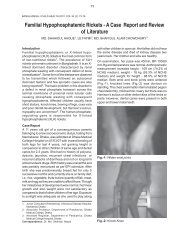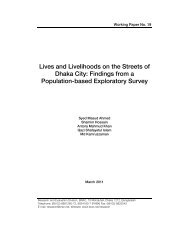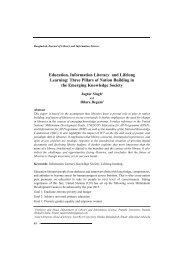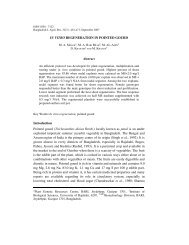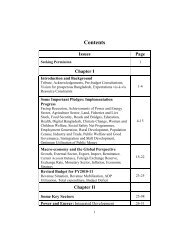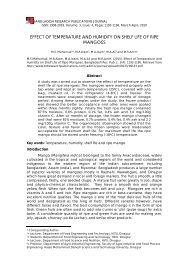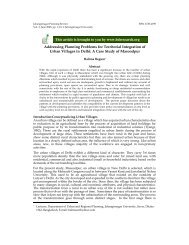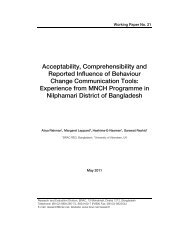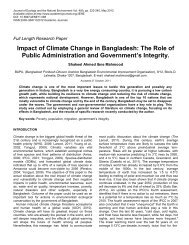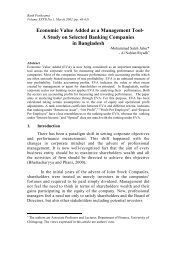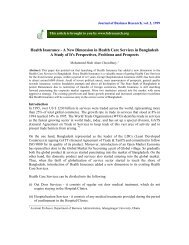Studies on Policy Option for Quality Seed Production and ... - NFPCSP
Studies on Policy Option for Quality Seed Production and ... - NFPCSP
Studies on Policy Option for Quality Seed Production and ... - NFPCSP
Create successful ePaper yourself
Turn your PDF publications into a flip-book with our unique Google optimized e-Paper software.
Table 4.2.27 Men, women <strong>and</strong> children’s participati<strong>on</strong> in wheat seed producti<strong>on</strong> activitiesParameter Male (%) Female (%) Child (%)L<strong>and</strong> preparati<strong>on</strong> 100 0 0Plowing 100 0 0<strong>Seed</strong>ing 100 0 0Birds beating 30 0 70Fertilizing & Manuring 100 0 0Irrigati<strong>on</strong> 100 0 0Weeding 40 60 0Roughing 100 0 0Rat c<strong>on</strong>trol 60 30 10Harvesting 70 30 0Carrying 40 60 0Threshing 50 50 0Winnowing 20 80 0Drying 80 5 15<strong>Seed</strong> preservati<strong>on</strong> 30 70 0<strong>Seed</strong> sale 90 10 04.2.31 Wheat producti<strong>on</strong> packagesThe existing wheat producti<strong>on</strong> packages as menti<strong>on</strong>ed by the farmers are described as follows.L<strong>and</strong> <strong>and</strong> soil type: In the study village, all cultivable l<strong>and</strong> is of high <strong>and</strong> medium topography,covering s<strong>and</strong>y loam soil <strong>and</strong> wheat is cultivated in the high <strong>and</strong> medium high l<strong>and</strong>s.L<strong>and</strong> preparati<strong>on</strong> <strong>and</strong> seed sowing: For wheat cultivati<strong>on</strong>, farmers start ploughing the l<strong>and</strong> in 2 ndweek of November <strong>and</strong> c<strong>on</strong>tinue up to the last of November. They plough l<strong>and</strong> 2-3 times with PowerTiller. Farmers sow the seeds a week or two weeks after starting of ploughing the l<strong>and</strong> i.e. from 25November to 7 December. Generally they broadcast the seeds at the rate of 150-185 kg/ha. About 5%of the farmers sow seeds in line. They prepare furrow (10-15 cm apart) using old plough. In case of linesowing, farmers use 135-150 kg/ha seeds. When seed germinati<strong>on</strong> fails, most of the farmers sow seedsagain particularly when the germinati<strong>on</strong> failure is higher. In case of less damage (failure), they allow togrow <strong>and</strong> take proper management, which might enhance tillering to compensate. If the failure of seedgerminati<strong>on</strong> is due to shortage of soil moisture, farmers wait <strong>for</strong> 10-15 days after sowing <strong>and</strong> thenirrigate. After irrigati<strong>on</strong> seeds germinate.Source of seed: About 60% farmers use their own seeds, 40% farmers use purchased seeds of which<strong>on</strong>ly 15% purchase from seed dealer <strong>and</strong> 25% purchase from market (other farmers’ seeds). Farmerscollect the seeds of old varieties if their own seeds are damaged. Most of the farmers collect seeds fromseed dealers or neighbours 1-2 days be<strong>for</strong>e sowing. Some collect seeds 7 days be<strong>for</strong>e sowing. Farmersc<strong>on</strong>firm the seed quality by observing shininess, boldness, spot-free <strong>and</strong> dry. In most cases, good seedsdepend <strong>on</strong> the source. Some of the farmers do germinati<strong>on</strong> test, but most of them do not.Manure <strong>and</strong> fertilizer use pattern: Most of the farmers apply cow dung/compost after 1 st ploughingin various amounts, ranging from 4 - 4.25 t/ha. They use their own cow dung or purchase if needed.They use chemical fertilizers at the rate of 60-35-37-95-3 kg/ha of urea-TSP-MP-Gypsum-Borax be<strong>for</strong>e



